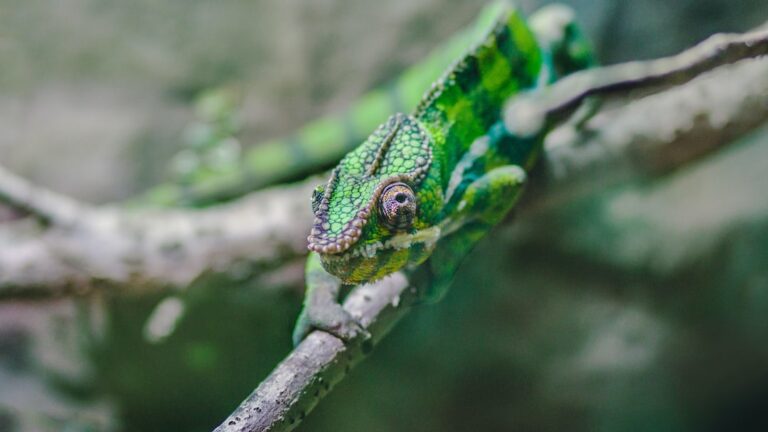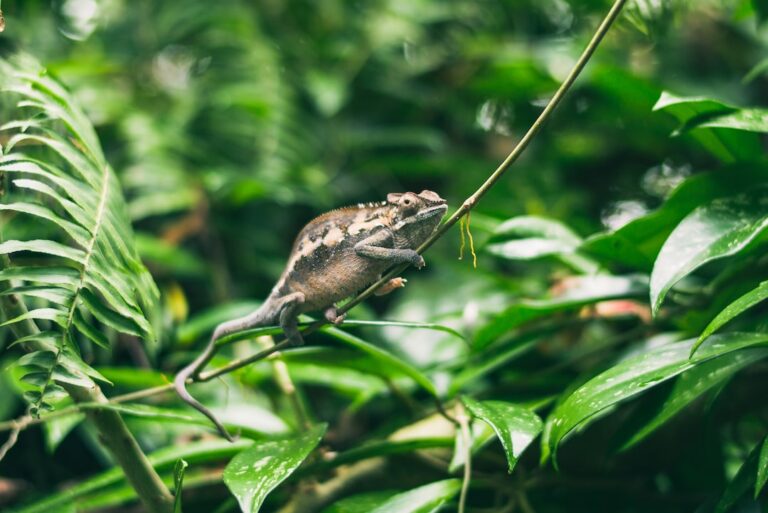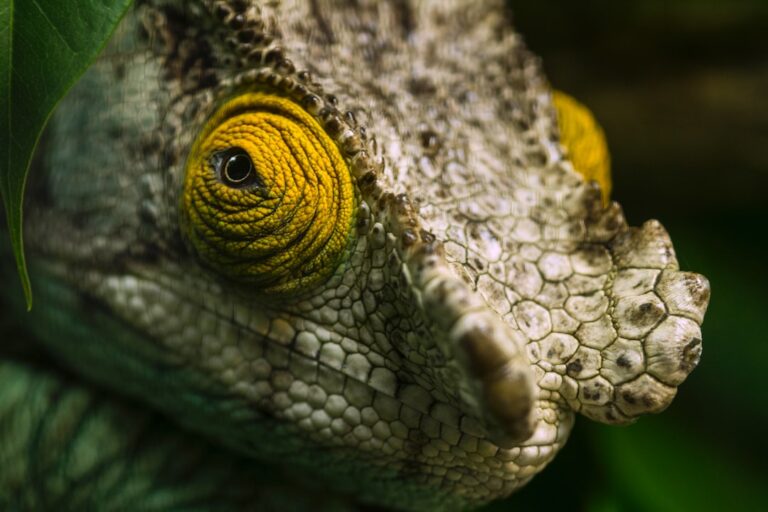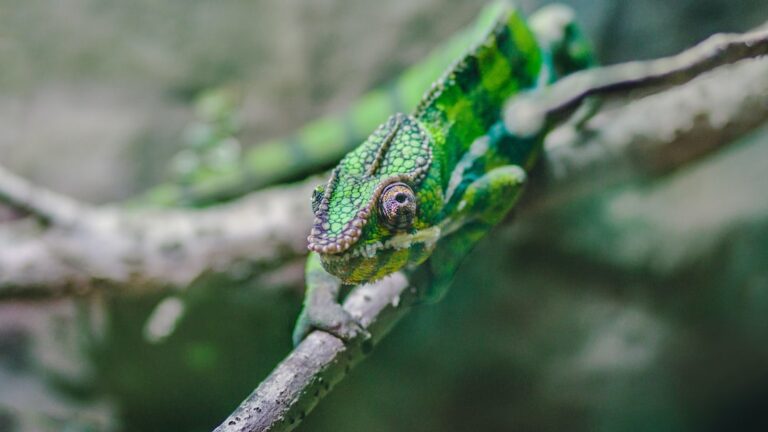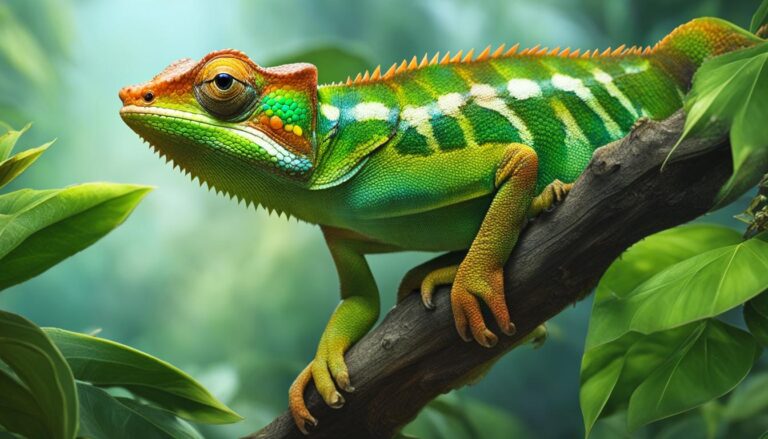Can Chameleons Sleep Upside Down?
Chameleons are fascinating creatures known for their ability to change color and blend into their surroundings. They belong to the reptile family and are native to Africa, Madagascar, and parts of Asia and Europe. Chameleons have a unique set of characteristics that set them apart from other reptiles. They have independently moving eyes, a long, sticky tongue for catching prey, and specialized feet for climbing trees. These adaptations make them highly skilled hunters and allow them to thrive in their natural habitats.
Understanding chameleon behavior and needs is crucial for their health and well-being. Chameleons are solitary animals that require specific environmental conditions to thrive. They are highly sensitive to changes in temperature, humidity, and lighting. Additionally, they have specific dietary requirements and need access to fresh water. By understanding their unique characteristics and providing them with the right care, we can ensure that chameleons live happy and healthy lives.
Table of Contents
The sleeping habits of chameleons
Chameleons have distinct sleep patterns that differ from other animals. Unlike mammals that have a regular sleep-wake cycle, chameleons do not have a specific sleep schedule. Instead, they sleep intermittently throughout the day and night. This is known as polyphasic sleep.
During the day, chameleons often take short naps while perched on branches or leaves. They may close their eyes or partially shut them while sleeping. These naps can last anywhere from a few minutes to a couple of hours. Chameleons are known for their ability to sleep with one eye open, allowing them to remain vigilant for potential predators or prey.
At night, chameleons typically sleep more deeply. They find a secure spot to rest, such as a branch or leaf, and enter a state of deep sleep. During this time, their body temperature drops, and their metabolic rate slows down. Chameleons may sleep for several hours at a time during the night.
Can chameleons sleep upside down?
Chameleons have the ability to sleep in various positions, including upside down. This is due to their unique anatomy and specialized feet. Chameleons have zygodactyl feet, which means that their toes are arranged in a way that allows them to grip onto branches and other surfaces. This adaptation enables them to climb and hang from branches, as well as sleep in different positions.
Sleeping upside down can be advantageous for chameleons as it allows them to conserve energy and stay hidden from predators. By sleeping upside down, they can blend into the underside of leaves or branches, making it more difficult for predators to spot them. Additionally, sleeping in this position allows chameleons to take advantage of the natural cover provided by foliage.
Understanding the anatomy of chameleons and how it affects their sleeping position
Chameleons have a unique anatomy that influences their sleeping position. Their bodies are designed for life in trees, with adaptations that allow them to navigate their arboreal habitats. Chameleons have a prehensile tail that they can use to grasp onto branches and stabilize themselves while climbing or sleeping.
Their feet are another important adaptation for their arboreal lifestyle. Chameleons have specialized feet with fused toes that form a claw-like structure. This allows them to grip onto branches and surfaces securely. The arrangement of their toes, known as zygodactyl feet, enables them to hold onto branches in various positions, including upside down.
These anatomical features make it possible for chameleons to sleep upside down without falling or losing their grip. Their strong feet and prehensile tail provide stability and allow them to maintain their position while sleeping.
The benefits and risks of sleeping upside down for chameleons
Sleeping upside down offers several advantages for chameleons. One of the main benefits is the ability to conserve energy. By sleeping in a position where they can blend into their surroundings, chameleons can avoid expending unnecessary energy on maintaining their camouflage. This allows them to rest and recharge while remaining hidden from predators.
Sleeping upside down also provides chameleons with a sense of security. By hanging from branches or leaves, they can take advantage of the natural cover provided by foliage. This makes it more difficult for predators to spot them while they sleep.
However, there are also potential risks and concerns associated with sleeping upside down. Chameleons that sleep in this position may be more vulnerable to falling or losing their grip. If they are not securely attached to a branch or leaf, they could potentially injure themselves if they fall while sleeping.
Additionally, sleeping upside down for extended periods may put strain on their muscles and joints. Chameleons that sleep in this position should have access to a variety of perching options to prevent muscle fatigue or discomfort.
How chameleons adapt to different sleeping positions in the wild
In the wild, chameleons adapt their sleeping positions based on their environment and the available resources. They have the ability to adjust their body posture and grip onto branches or leaves in various positions.
Chameleons may sleep on horizontal branches, vertically against tree trunks, or even upside down underneath leaves. They choose their sleeping position based on factors such as temperature, humidity, and safety. By adapting to different sleeping positions, chameleons can maximize their chances of survival in their natural habitats.
The importance of providing a comfortable sleeping environment for pet chameleons
Creating a comfortable sleeping environment is crucial for pet chameleons’ health and well-being. Chameleons require a secure and stable place to sleep, as well as access to appropriate temperature and humidity levels. Providing a comfortable sleeping area can help reduce stress and promote healthy sleep patterns.
Chameleons should have access to a variety of perching options in their enclosure. This can include branches, vines, or other structures that mimic their natural habitat. The perches should be securely attached and able to support the weight of the chameleon.
It is also important to ensure that the temperature and humidity levels in the enclosure are appropriate for the species of chameleon. Chameleons are ectothermic, which means they rely on external heat sources to regulate their body temperature. Providing a temperature gradient within the enclosure allows chameleons to choose their preferred sleeping temperature.
Tips for creating a safe and comfortable sleeping area for chameleons
When setting up a sleeping area for chameleons, there are several factors to consider:
1. Perching options: Provide a variety of perching options at different heights and angles. This allows chameleons to choose their preferred sleeping position.
2. Stability: Ensure that the perches are securely attached and can support the weight of the chameleon. Avoid using materials that may break or collapse under the chameleon’s weight.
3. Temperature gradient: Create a temperature gradient within the enclosure by using heat lamps or heating pads. This allows chameleons to choose their preferred sleeping temperature.
4. Humidity levels: Monitor and maintain appropriate humidity levels within the enclosure. This can be achieved by misting the enclosure regularly or using a humidifier.
5. Lighting: Provide appropriate lighting for your chameleon’s sleep-wake cycle. Chameleons require a period of darkness at night to promote healthy sleep patterns.
Common sleeping problems in chameleons and how to address them
Chameleons may experience various sleeping problems that can affect their health and well-being. Some common issues include:
1. Insomnia: Chameleons may have difficulty falling asleep or staying asleep. This can be caused by factors such as improper lighting, temperature, or humidity levels. Addressing these environmental factors can help improve sleep quality.
2. Stress: Chameleons that are stressed or anxious may have trouble sleeping. It is important to provide a calm and quiet environment for your chameleon to promote relaxation and reduce stress.
3. Inadequate perching options: If your chameleon does not have suitable perching options, they may struggle to find a comfortable sleeping position. Ensure that there are enough perches available and that they are securely attached.
4. Health issues: Certain health conditions, such as respiratory infections or parasites, can disrupt a chameleon’s sleep patterns. If you suspect that your chameleon is unwell, consult a veterinarian for proper diagnosis and treatment.
Understanding chameleon behavior and meeting their unique needs
In conclusion, understanding chameleon behavior and meeting their unique needs is crucial for their health and well-being. Chameleons have distinct sleep patterns and the ability to sleep in various positions, including upside down. Their anatomy and specialized feet allow them to grip onto branches and sleep securely.
Creating a comfortable sleeping environment for pet chameleons is essential. Providing a variety of perching options, appropriate temperature and humidity levels, and a calm and quiet environment can promote healthy sleep patterns.
By understanding chameleon behavior and meeting their unique needs, we can ensure that these fascinating creatures thrive in captivity and live happy and healthy lives.
If you’re curious about the sleeping habits of chameleons, you might also be interested in learning about their diet. Did you know that chameleons can eat superworms? Find out more about this fascinating aspect of their feeding habits in our article, “Can Chameleons Eat Superworms?“. Discover the nutritional benefits and considerations of including superworms in a chameleon’s diet.



